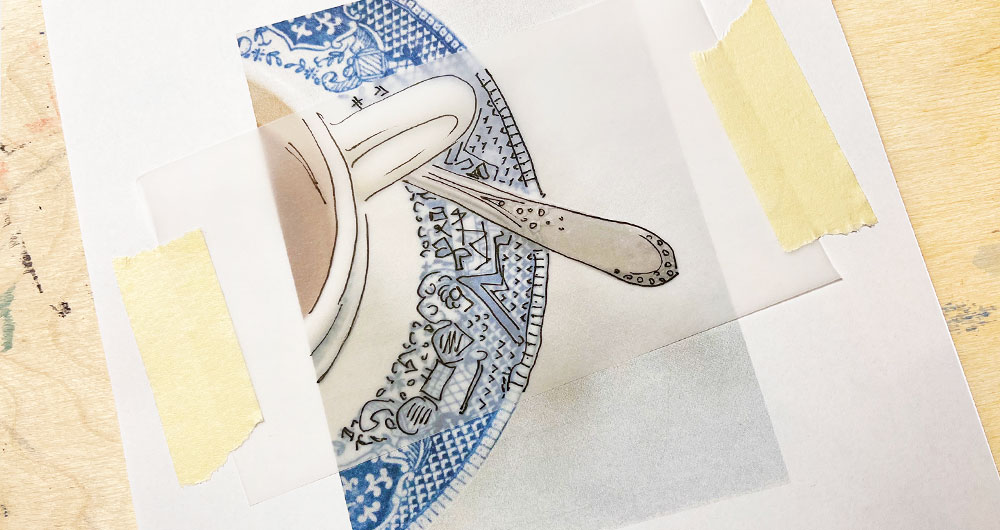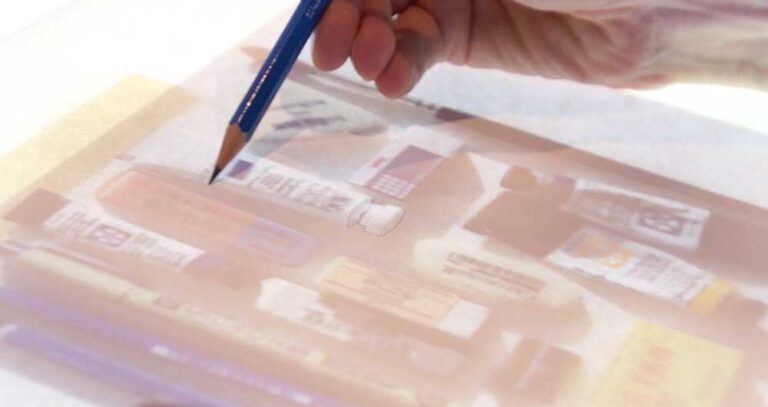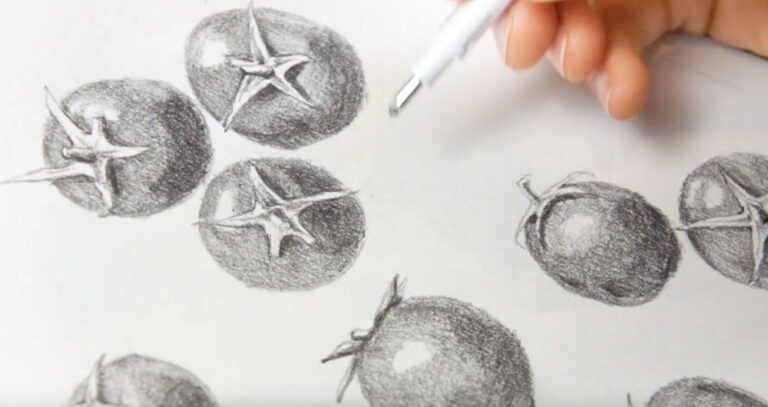Is Tracing Art Bad? (Find Out The Truth!)

I’ve come across some artists who are against the idea of using tracing techniques. Personally, I use tracing all the time!
But should you consider tracing art as cheating or plagiarism?
It’s been a subject of debate for many years…
But rather than having a fixed view of the morals of tracing, it’s important to understand the context behind its use in artwork.
Is tracing art so bad? I know what I think…
What is tracing in art?
Tracing is the artistic practice of reproducing and transferring an existing image to a new surface. This method is used to get a more accurate copy of an image or replicate detailed parts of a reference. Tracing in art can be done using a number of different techniques.
The practice of tracing and reproducing designs has an extremely long history in art. Modern artists aren’t the first to come up with this idea:-)
For example, the ancient Egyptians used a tracing technique known as “pouncing” to copy outlines onto a surface.
They would make an accurate outline on a sheet of fabric and then perforate the lines with small holes. This was placed over a new surface and sprinkled with charcoal or pigment powder, which was pushed through the holes. The dotted outline was used as a guide for painting.
It’s even possible that many of the masterpieces we admire today used some kind of tracing method! A few researchers suggest that as far back as 1430, artists used optical projections of real-life subjects with lenses.
Tracing methods were, and still are, used by many artists for learning and practice or when accurate reproduction is necessary.
Over the years, artists have come up with a multitude of ingenious ways to transfer pictures.
Some Tracing Techniques:

Some of the more common ways to transfer art include:
- Transfer paper – artists place a sheet of graphite-coated paper between the reference image and the destination surface. The pressure applied while drawing over the image transfers marks to the surface beneath.
- Projection methods – You can use an optical projector to “project” the original image onto a surface for tracing. This is very practical for changing the scale of the picture. (Amazon)
- The grid method – By drawing a series of equally spaced lines over the reference image and the destination sheet, artists draw what they see in each grid onto the corresponding square on the blank sheet.
- Freehand tracing – You can copy an image using a transparent sheet of tracing paper. The artist hand draws directly on top, then rubs graphite on the back of the tracing paper. By drawing over the outline, you can transfer it to a different surface.
- Light tables and lightboxes – These handy devices illuminate the source image from behind. You can then place a blank sheet on top and use the back-lit image to copy an outline.
- Use a window – if you don’t have a light table, similar results can be achieved by taping your reference onto glass. Place a sheet of paper on top, and the image will show through, making it possible to trace.
Is Tracing Art Bad?
Tracing art is not bad, and there are many valid reasons for using tracing methods in your creative endeavors.
Let me put your mind at rest if you’re in an agonizing dilemma about whether tracing artwork is cheating.
No! It is not… And here are some excellent reasons why:
- Tracing is a valuable time-saving technique.
- It helps start your artwork with the correct proportions.
- Composite artwork: Create new compositions and combine elements in new creative ways.
- Use simplified tracing and finish the drawing yourself, leaving most of the creative skill to the artist.
- Learning: Trace only a few reference lines and finish with hand- drawing to improve your skills.
- Incorporate elements from your previous sketches or artwork.
- Artistic Exploration: You can fill a traced outline using your imagination and individual creative style.
- More precise basis for a work of art (particularly when working on complicated subjects and details).
- Practice: Tracing the same subject several times to practice drawing specific things.
- Change the scale of a drawing without losing proportions.
I’m sure you can probably think of some other good reasons 🙂
Some of you may know that I trained and worked as an architect. Tracing was an essential part of the creative process when I was studying. I remember we used to buy translucent rolls of thin yellow training paper (vast amounts of the stuff!). I would use my previous sketches to trace over, keeping the interesting parts and coming up with new options. Also, to work on plans of different building levels, tracing was an indispensable work tool!
Not all tracing is bad, and it can be a legitimate part of a creative process. Tracing can be just as innovative as drawing from scratch.
If you think about it, artists use some form of tracing or copying all the time. For example, artists often use proportional dividers or grid methods to obtain the proper scale and proportions.
If you’re not confident about drawing a subject using freehand, tracing is an excellent helping hand to get started.
When working with watercolors, I trace my artwork all the time, and I encourage my students to do the same. It’s a great way to get started quickly from an accurate outline.
And to be honest, I’m too impatient to get on with the painting part to spend loads of time making a precise drawing 🙂
My preferred method of tracing is to use a light box like this. This is the quickest and most straightforward approach to tracing a sketch outline.

There’s another perfectly good reason why watercolor artists should trace their outlines onto watercolor paper. The surface of watercolor paper is delicate. Try spending time erasing and re-drawing a sketch outline! You will end up ruining the surface sizing and altering the handling properties of the paper.
Read my guide for more detailed help on how to trace pictures onto paper.
Is tracing art good for beginners?
Tracing can be a valuable tool for beginners. Artists have been using tracing techniques as a way to emulate and learn from others for centuries! Or simply as a way to make the first stages of an artwork easier.
You’ll even find a bunch of phone apps to help with this process!
Tracing apps
Tracing is often used to recreate a contour or outline of the subject. But this is only a tiny part of the creative process. Artistic skill is still needed to complete the picture, and the most challenging aspect of successful artwork relies on building your drawing and painting skills.
Tracing can help you achieve accuracy, but it doesn’t replace the need for understanding concepts such as perspective, composition, values, shading, color mixing, and color theory! These fundamental skills form the foundation of any artistic capabilities.
By the way, if you’re interested in learning all these fundamental skills concerning watercolor painting, check out my Watercolor Masterclass!
Is tracing a bad way to learn?
Using some form of tracing is good when learning to draw and helps produce more confident lines and hand-to-eye coordination. However, the use of tracing should be measured against the artist’s purpose.
Tracing is a helpful support technique to get you progressing in the right direction when you’re learning to draw or paint. A large part of drawing accurately is about comparing your work with the original reference. Artists use various methods to accomplish this, including tracing.
But remember, if your overall objective is to learn to draw by hand, it should not wholly replace drawing by eye.
Challenge yourself to draw using observation techniques rather than tracing.
Find your art style through tracing
Tracing can be a starting point for artists to experiment with different styles, compositions, or color schemes. It provides a framework that artists can modify or enhance to create unique and original artworks.
Tracing can also serve as a valuable exercise for artists seeking to discover and refine their artistic style. By tracing various reference images or designs in different styles, artists can understand what resonates with them creatively.
Is tracing still art?
Artistic expression can take a wide range of forms. The act of tracing is not widely considered “art,” and it’s more like a tool or technique that can serve educational or some practical use. But it can be regarded as part of the artistic process, especially when used as a foundation for more elaborate and creative work.
And if you trace your artwork, you’re not alone. Plenty of well-known artists have used this process to benefit their art…
Famous artists who trace
- Pablo Picasso occasionally used tracing and transfer techniques in his early career. One example is his 1904 painting “La Vie,” in which he incorporated traced elements from earlier sketches into the composition.
- Andy Warhol frequently used a slide projector to trace and reproduce iconic images in his sketches.
- Chuck Close, known for his photorealistic portraits, transposed photographs onto canvas. His large-scale paintings, such as “Big Self-Portrait,” are created through this method.
- Edgar Degas, the Impressionist artist, utilized tracing and transferring techniques in his drawings and pastels. He often traced from his own sketches and photographs.
- Leonardo da Vinci employed the grid method and is suspected of using other techniques, such as lens projections, to transfer his intricate sketches and studies onto various surfaces.
To trace or not to trace?
I’m a big fan of tracing; if I couldn’t quickly transfer my references onto watercolor paper, I would lose a lot of time. That’s the main reason why I regularly trace.
What’s wrong with that?
And after all, I’m only translating an outline onto the sheet.
Believe me, the work is far from finished at that point 🙂




I do a lot of portraits where I use a tracing app or transfer paper. I just mark where the eyes, nose, mouth and shadows are. Then I know the proportions are correct. The rest I fill from the reference picture. Without out it, it would take a lot longer to get to actual painting and drawing is not my favorite thing.
mmmm…WOW! I have struggled with the idea of tracing. It just feels wrong. I do spend a LOT of time by not tracing and I have wrecked watercolor paper and had to start over..lolo
Hey if it is good enough for Picasso, Degas and da Vinci….I think I will give it a try!!!
I did art for years and then I discovered sewing and kids! Now, I am newly retired and trying to go back to my first love…art. It is slow going and I am not nearly as good as I used to be….a LOT of wasted paper!!!
I took a one day WC class and was shocked to hear of tracing. As well as from many YouTube artist.
Thanks!!!
Hi Addie
Hope this give you the reassurance to use tracing to help you progress 🙂
Have fun!
I sent my sister a projector a month ago, I can’t live w/o mine! Even the cheapest ones work really well!!
Good to know Clair 🙂
Terrific post–they always are. I’m a big proponent of tracing, and, judging from your list of brilliant artists, I am in impressive company. I learned various methods when I was in a textile design program and my (highly experienced) instructors were also all for the method.
One more transfer trick I used to use before I bought a good-quality light box: I used one of my two glass-topped tables with excellent results: I would flashlight under it (shining upward), place the drawing to be copied face up on the glass, place the watercolor or gouache paper on top, and trace that way.
Great tip June !
Thanks 🙂
Totally agree -great article
Thanks Ellen
Great piece! Thank you.
You’re welcome Barb 🙂